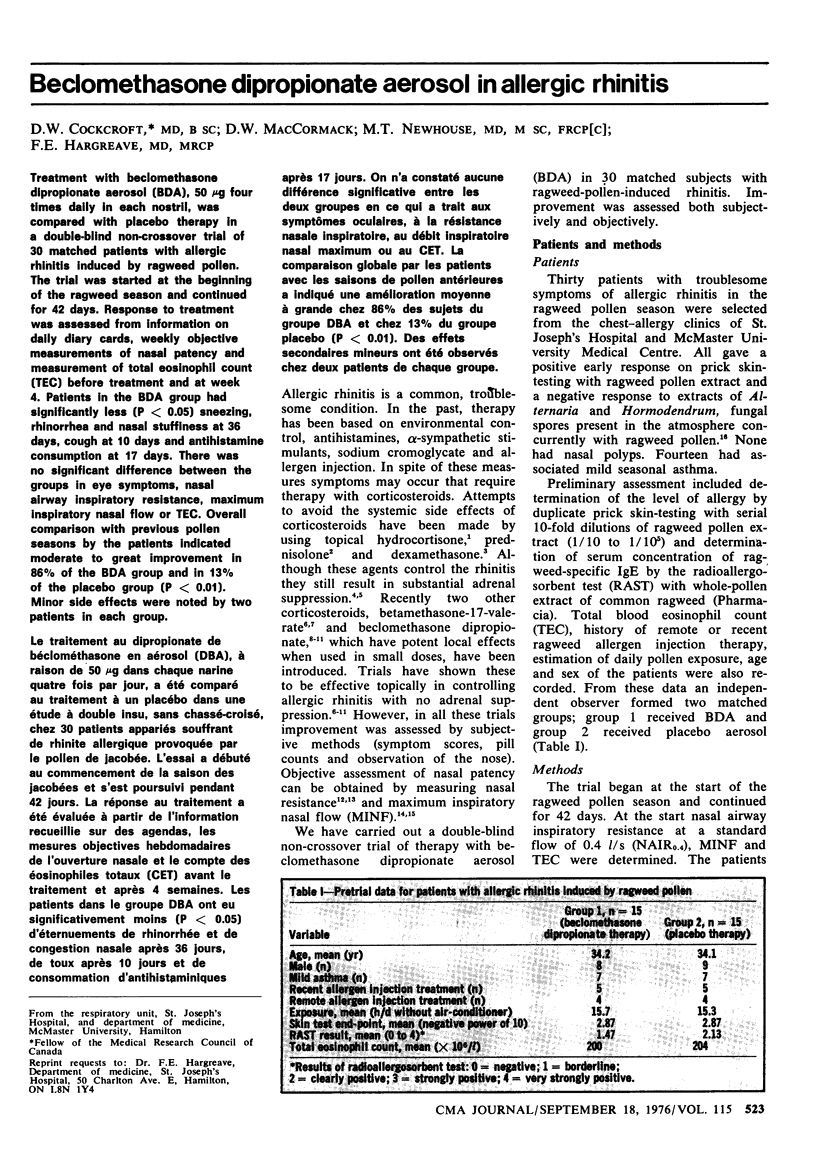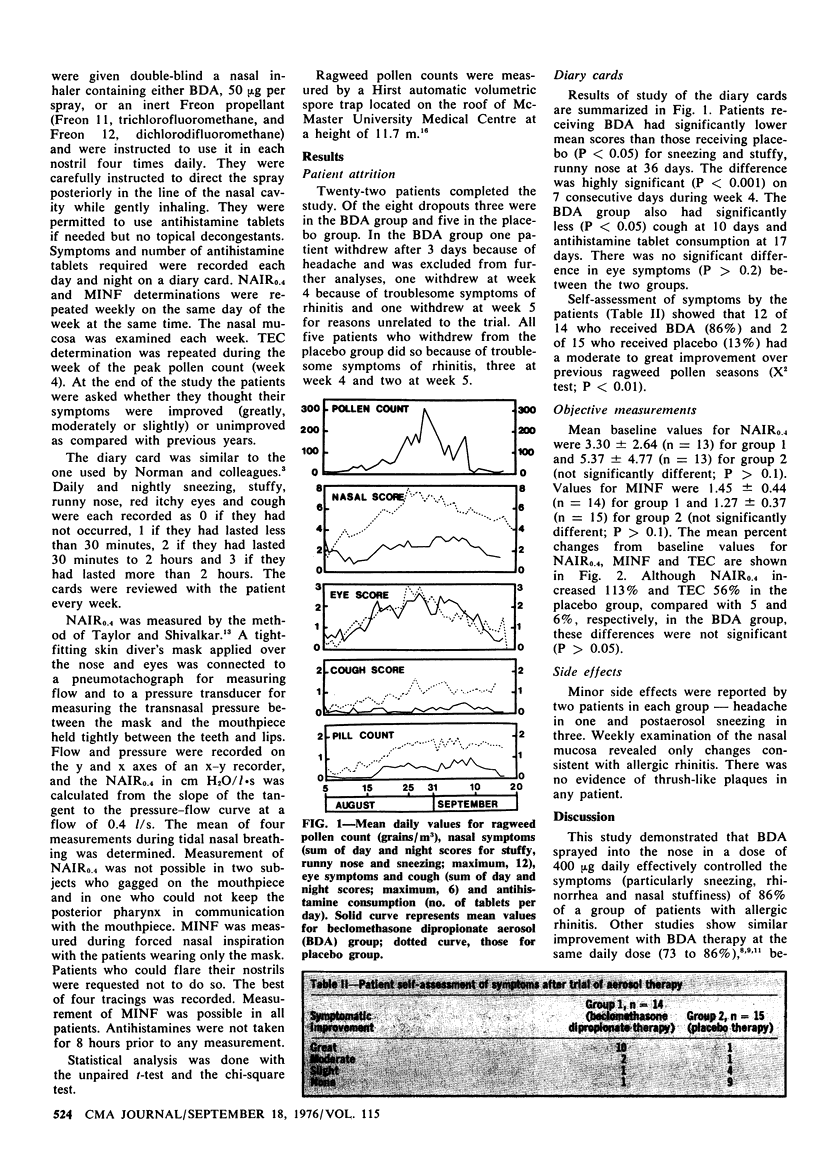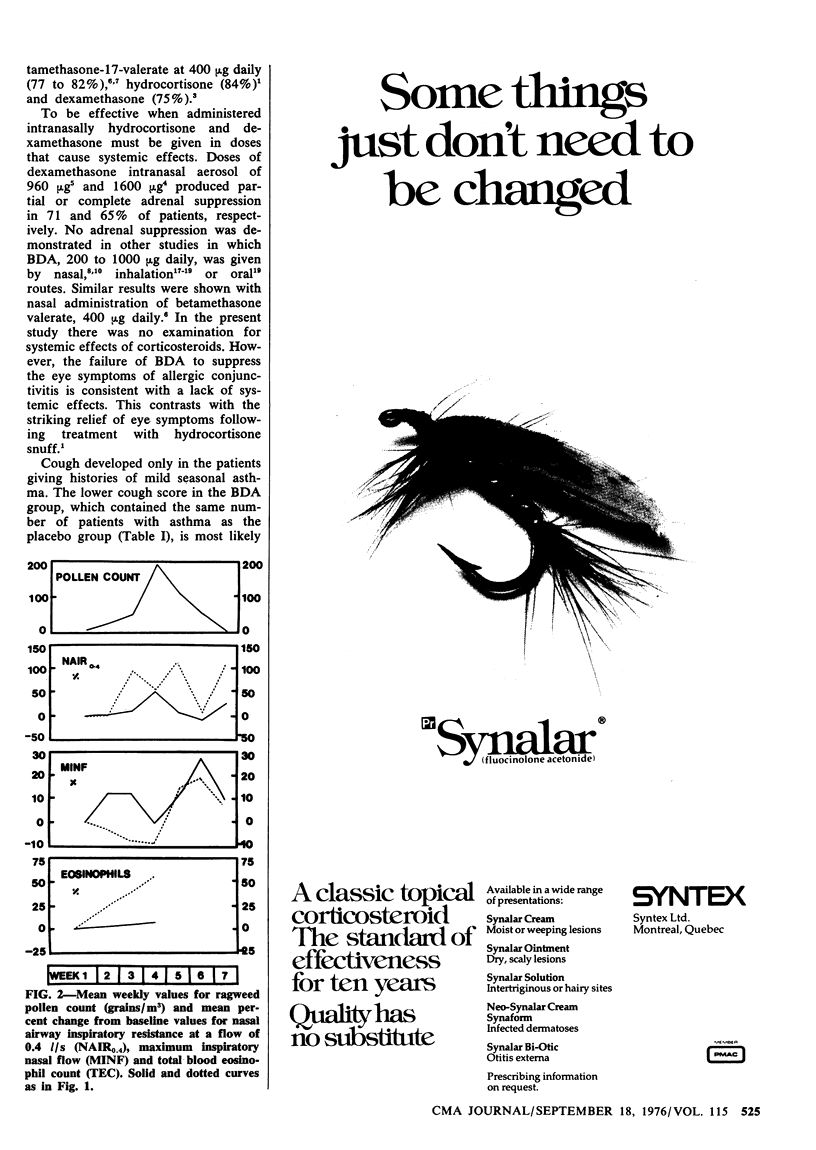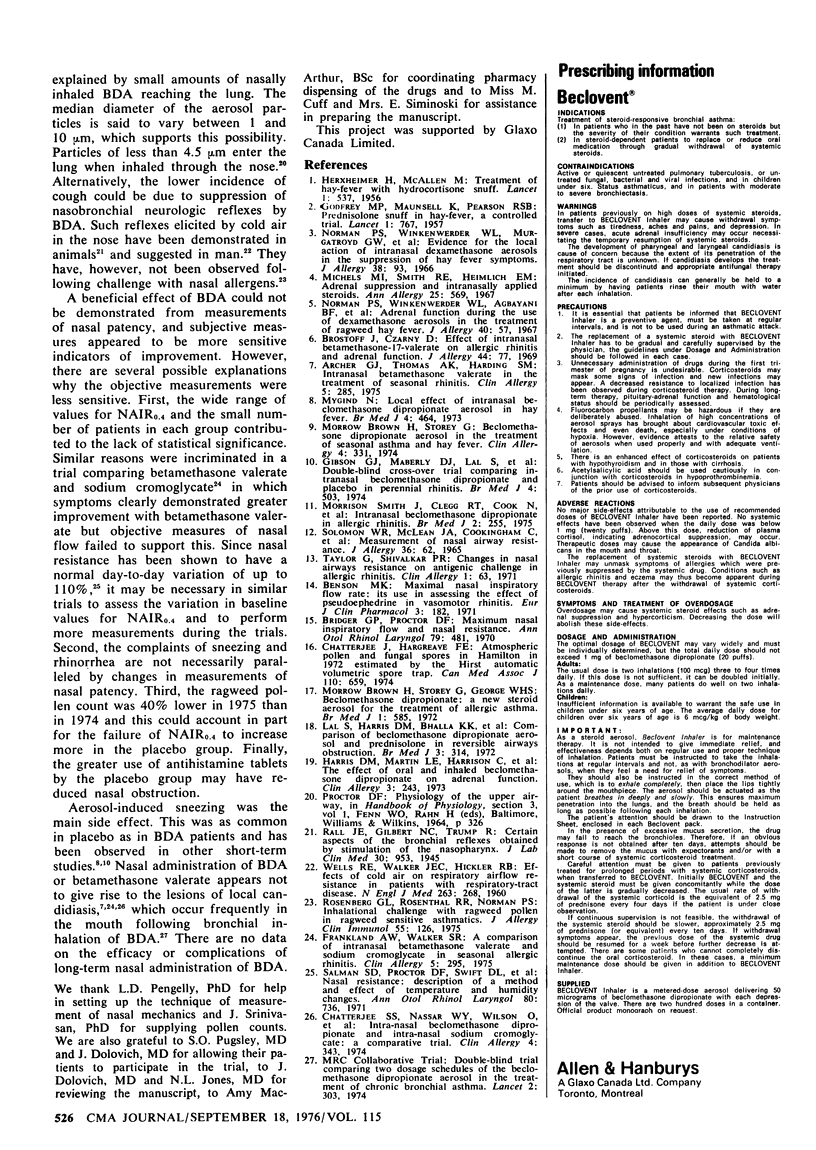Abstract
Treatment with beclomethasone dipropionate aerosol (BDA), 50 mug four times daily in each nostril, was compared with placebo therapy in a double-blind non-crossover trial of 30 matched patients with allergic rhinitis induced by ragweed pollen. The trial was started at the beginning of the ragweed season and continued for 42 days. Response to treatment was assessed from information on daily diary cards, weekly objective measurements of nasal patency and measurement of total eosinophil count (TEC) before treatment and at week 4. Patients in the BDA group had significantly less (P less than 0.05) sneezing, rhinorrhea and nasal stuffiness at 36 days, cough at 10 days and antihistamine consumption at 17 days. There was no significant difference between the groups in eye symptoms, nasal airway inspiratory resistance, maximum inspiratory nasal flow or TEC. Overall comparison with previous pollen seasons by the patients indicated moderate to great improvement in 86% of the BDA group and in 13% of the placebo group (P less than 0.01). Minor side effects were noted by two patients in each group.
Full text
PDF



Selected References
These references are in PubMed. This may not be the complete list of references from this article.
- Archer G. J., Thomas A. K., Harding S. M. Intranasal betamethasone valerate in the treatment of seasonal rhinitis. Clin Allergy. 1975 Sep;5(3):285–290. doi: 10.1111/j.1365-2222.1975.tb01864.x. [DOI] [PubMed] [Google Scholar]
- Bridger G. P., Proctor D. F. Maximum nasal inspiratory flow and nasal resistance. Ann Otol Rhinol Laryngol. 1970 Jun;79(3):481–488. doi: 10.1177/000348947007900308. [DOI] [PubMed] [Google Scholar]
- Brostoff J., Czarny D. Effect of intranasal betamethasone-17-valerate on allergic rhinitis and adrenal function. J Allergy. 1969 Aug;44(2):77–81. doi: 10.1016/0021-8707(69)90003-3. [DOI] [PubMed] [Google Scholar]
- Chatterjee J., Hargreave F. E. Atmospheric pollen and fungal spores in Hamilton in 1972 estimated by the Hirst automatic volumetric spore trap. Can Med Assoc J. 1974 Mar 16;110(6):659–passim. [PMC free article] [PubMed] [Google Scholar]
- Frankland A. W., Walker S. R. A comparison of intranasal betamethasone valerate and sodium cromoglycate in seasonal allergic rhinitis. Clin Allergy. 1975 Sep;5(3):295–300. doi: 10.1111/j.1365-2222.1975.tb01866.x. [DOI] [PubMed] [Google Scholar]
- Gibson G. J., Maberly D. J., Lal S., Ali M. M., Butler A. G. Double-blind cross-over trial comparing intranasal beclomethasone dipropionate and placebo in perennial rhinitis. Br Med J. 1974 Nov 30;4(5943):503–504. doi: 10.1136/bmj.4.5943.503. [DOI] [PMC free article] [PubMed] [Google Scholar]
- HERXHEIMER H., MCALLEN M. Treatment of hay-fever with hydrocortisone snuff. Lancet. 1956 Apr 28;270(6922):537–539. doi: 10.1016/s0140-6736(56)90596-7. [DOI] [PubMed] [Google Scholar]
- Harris D. M., Martin L. E., Harrison C., Jack D. The effect of oral and inhaled beclomethasone dipropionate on adrenal function. Clin Allergy. 1973 Sep;3(3):243–248. doi: 10.1111/j.1365-2222.1973.tb01329.x. [DOI] [PubMed] [Google Scholar]
- Lal S., Harris D. M., Bhalla K. K., Singhal S. N., Butler A. G. Comparison of beclomethasone dipropionate aerosol and prednisolone in reversible airways obstruction. Br Med J. 1972 Aug 5;3(5822):314–317. doi: 10.1136/bmj.3.5822.314. [DOI] [PMC free article] [PubMed] [Google Scholar]
- Michels M. I., Smith R. E., Heimlich E. M. Adrenal suppression and intranasally applied steroids. Ann Allergy. 1967 Oct;25(10):569–574. [PubMed] [Google Scholar]
- Mygind N. Local effect of intranasal beclomethasone dipropionate aerosol in hay fever. Br Med J. 1973 Nov 24;4(5890):464–466. doi: 10.1136/bmj.4.5890.464. [DOI] [PMC free article] [PubMed] [Google Scholar]
- Norman P. S., Winkenwerder W. L., Agbayani B. F., Migeon C. J. Adrenal function during the use of dexamethasone aerosols in the treatment of ragweed hay fever. J Allergy. 1967 Jul;40(1):57–61. doi: 10.1016/0021-8707(67)90060-3. [DOI] [PubMed] [Google Scholar]
- SOLOMON W. R., MCLEAN J. A., COOKINGHAM C., AHRONHEIM G., DEMUTH G. R. MEASUREMENT OF NASAL AIRWAY RESISTANCE. J Allergy. 1965 Jan-Feb;36:62–69. doi: 10.1016/0021-8707(65)90033-x. [DOI] [PubMed] [Google Scholar]
- Salman S. D., Proctor D. F., Swift D. L., Eveering S. A. Nasal resistance: description of a method and effect of temperature and humidity changes. Ann Otol Rhinol Laryngol. 1971 Oct;80(5):736–743. doi: 10.1177/000348947108000516. [DOI] [PubMed] [Google Scholar]
- Smith J. M., Clegg R. T., Cook N., Butler A. G. Intranasal beclomethasone diproprionate in allergic rhinitis. Br Med J. 1975 May 3;2(5965):255–255. doi: 10.1136/bmj.2.5965.255. [DOI] [PMC free article] [PubMed] [Google Scholar]
- WELLS R. E., Jr, WALKER J. E., HICKLER R. B. Effects of cold air on respiratory airflow resistance in patients with respiratory-tract disease. N Engl J Med. 1960 Aug 11;263:268–273. doi: 10.1056/NEJM196008112630602. [DOI] [PubMed] [Google Scholar]


